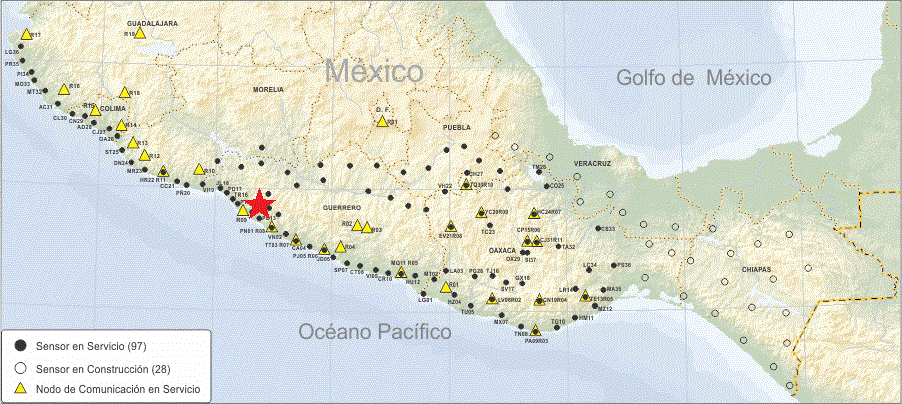Seismo Blog
What Mexico Has, California Is Lacking
Categories: Earthquake Early Warning | Mexico
April 19, 2014
This Good Friday started off as a lush, beautiful morning in Mexican's beach resort town of Acapulco. Thousands of tourists, mainly Mexicans, had gathered there to celebrate the Easter weekend, an important holiday in this mostly Catholic country. However, the peaceful atmosphere came to an abrupt end at 09:27 am local time, when an earthquake with a magnitude of 7.2 struck in the mountains about 80 miles northwest of the city. The seismic waves made the ground under Acapulco rattle and sway and frightened visitors and locals alike. Despite the strong shaking, no significant damage or injuries were reported.
The buildings in the popular resort town were not the only items shaken by the temblor. Within seconds of the earthquake's initiation about half a dozen seismic sensors in the Mexican state of Guerrero registered the initial seismic waves. These instruments are part of a dense network of accelerometers along Mexico's Pacific coast called Sasmex. This acronym stands for "Seismic Alert System in Mexico" and is comprised of almost 100 hundred sensors, which continuously transmit their recordings in realtime to a data center. There computers automatically sift through the data looking for suspicious signals. Once the computers recognized the shaking initially recorded by these six sensors in Guerrero, they went into action: First they calculated the location of the hypocenter, the magnitude of the earthquake and the time it would take for the shaking to reach major population centers in our neighboring country. Because the magnitude of quake near Acapulco easily exceeded a certain threshold, the computers issued a warning about the impending danger.
On Friday only 11 seconds passed between the origin time of the earthquake the issuance of the alert. A few seconds later this alert was braodcast by dedicated radio transmitters in Mexico's largest cities. Because Sasmex alerts are issued so quickly and seismic waves travel more slowly across the country, the alerts reached the population of Mexico City 71 seconds before the shaking started. Morelia, the largest city in Michoacan, had 58 seconds to prepare and the warning time for Chilpancingo, the capital of Guerroro, was still 35 seconds although the city is located closer to the quake's epicenter.

A dense network of almost 100 seismic sensors (black dots) dots Mexico's Pacific coast as part of the country's seismic alert system. The yellow triangles are communication nodes. The opaque circles on this map depict future stations as an expansion of the network. The red star shows the location of Friday's earthquake. Map courtesy of Sasmex.
Mexico's government started to finance and build seismic alert systems shortly after the huge 8.1 quake, which devastated Mexico City in September 1985. Several years ago the various earthquake early warning initiatives in the country were integrated into Sasmex, which currently is able to detect and warn of earthquakes along the Pacific coast and in the central volcanic belt. Soon the alert system will be expanded into the states of Veracruz and Chiapas.
Mexico is not the only seismically active country in the world with such a warning system. Japan, Taiwan, Romania, Turkey and several other nations operate similar systems - but not the United States. Although the technology is available along the west coast (see blog on October 2, 2012) and a demonstration system is operating, a public alert system does not exist. California even has a law mandating Earthquake Early Warning, but this legislation has hardly any teeth, as it does not appropriate funds to build such a system. Mexico is clearly ahead of California when it comes to warning the populace of seismic shaking. (hra092)
BSL Blogging Team: Who we are
Recent Posts
-
: Alerts for the Whole West Coast
-
: Destruction in the Eastern Aegean Sea
-
: An Explosion in Beirut heard all over the Middle East
View Posts By Location
Categories
- Alaska (3)
- Bay Area (24)
- Buildings (3)
- Calaveras (4)
- California (13)
- California ShakeOut (3)
- Central California (4)
- Chile (4)
- Earthquake Early Warning (10)
- Earthquake Faults and Faulting (44)
- Earthquake Science (3)
- Haiti (3)
- Hayward (12)
- Indonesia (4)
- Induced Seismicity (3)
- Instrumentation (18)
- Italy (6)
- Japan (7)
- MOBB (3)
- Mendocino Triple Junction (5)
- Mexico (7)
- Nepal (3)
- North Korea (5)
- Nuclear Test (5)
- Ocean Bottom Seismometer (3)
- Oklahoma (4)
- Plate Tectonics (18)
- Preparedness, Risks, and Hazards (16)
- Salton Sea (3)
- San Andreas Fault (14)
- Seismic Waves (13)
- Seismograms (4)
- ShakeAlert (3)
- Southern California (5)
- Surface Waves (3)
- Today in Earthquake History (20)
- Volcanoes (4)
- subduction (3)